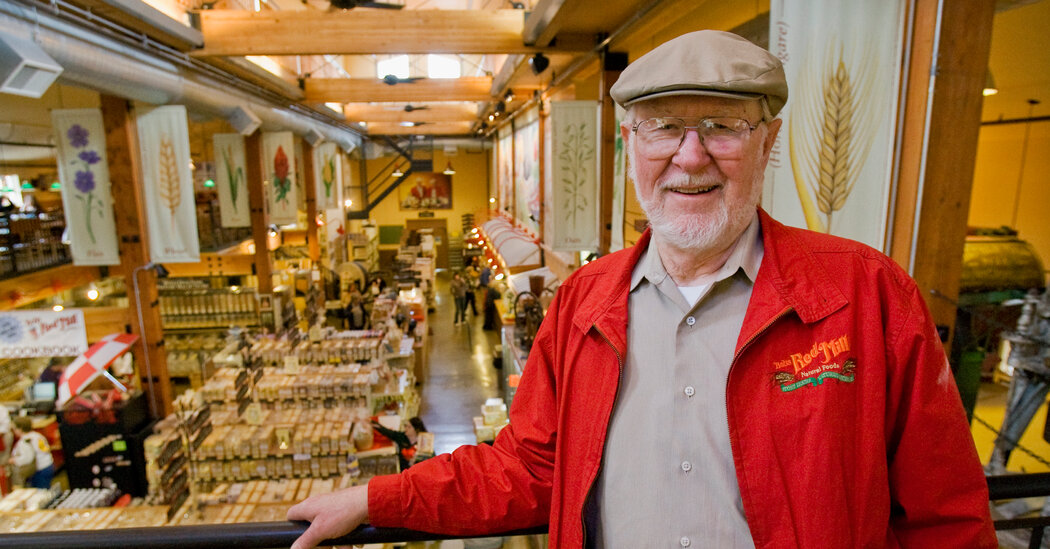Bob Moore, the grandfatherly entrepreneur who, with his wife, Charlee, leveraged an image of organic heartiness and wholesome Americana to turn the artisanal grain company Bob’s Red Mill into a $100 million dollar-a-year business, died on Saturday at his home in Milwaukie, Ore. He was 94.
His death was announced by the company, which did not cite a cause.
Founded in Milwaukie in 1978, Bob’s Red Mill grew from serving the Portland area to become a global natural-foods behemoth, marketing more than 200 products in more than 70 countries. The company’s product line runs a whole-grain gamut, including stone-ground sorghum flour, paleo-style muesli and whole wheat-pearl couscous, along with energy bars and cake and soup mixes.
Over the years, the company profited handsomely from the nutrition-minded shift away from processed foods and grains.
“I think that people who eat white flour, white rice, de-germinated corn — in other words, grains that have had part of their nutrients taken away — are coming up short,” Mr. Moore said in 2017 in an interview for an Oregon State University oral history. “I think our diets, nationally, and international probably, show the fact that we just have allowed ourselves to be sold a bill of goods.”
Despite the company’s explosive growth, Mr. Moore fended off numerous offers by food giants to buy Bob’s Red Mill. He opted instead for an employee stock ownership plan, instituted in 2010, on his 81st birthday; by April 2020, the plan had put 100 percent of the company in the hands of its more than 700 employees.
“The Bible says to do unto others as you would have them do unto you,” Mr. Moore, an observant Christian, said in discussing the plan in a recent interview with Portland Monthly magazine.
While Bob’s Red Mill is an ensemble effort in that sense, its marketing appeal is rooted in the cult of personality surrounding its hirsute founder.
Mr. Moore, known for his trademark red vest and white beard, frequently drew comparisons to Santa Claus. (He was also known for his bolo ties and newsie caps.) His gently smiling face adorns the package of every one of his company’s products, along with the tagline “To Your Good Health.”
“Everywhere I go, people recognize me,” Mr. Moore said in the 2017 interview, “and I always have somebody to talk to.”
With its folksy earth-tone packaging and its heavy emphasis on natural ingredients, Bob’s Red Mill managed to conjure an anti-corporate, back-to-the-land ethos reminiscent of the Whole Earth Catalog era of the 1970s, with clear appeal to ex-hippies and coastal wellness devotees.
At the same time, the amiable, white-haired Bob and Charlee Moore, sometimes seen pictured smiling in one of their two 1931 Ford Model A roadsters, projected a small-town wholesomeness that suggested a lost world of barbershop quartets and sarsaparilla floats that seemed perfectly tailored for the heartland.
The wholesomeness, it seems, was anything but an act. And it proved a building block to a nine-figure powerhouse.
Robert Gene Moore was born on Feb. 15, 1929, in Portland, the elder of two children of Ken and Doris Moore. He grew up in San Bernardino, Calif., outside Los Angeles, where his father, too, had a grain-adjacent job of sorts: He drove a Wonder Bread truck.
Bob was too young to enlist when World War II started, so he took a job in a warehouse for the May Company department store in Los Angeles. He was given an early taste of management at 16 when his boss promoted him to run his own department at the store.
“I walked out of his office — I didn’t walk out, I flew out,” he said on the NPR podcast “How I Built This With Guy Raz.” “I was just in seventh heaven.”
After a three-year stint in the Army, during which he helped build bridges and roads in the Marshall Islands, he returned to Southern California and met Charlee Lu Coote. The Moores married in 1953 and started a family that would include three boys.
Mr. Moore was still trying to settle on a career path when, driving down Crenshaw Boulevard in Los Angeles one day, he saw a “Coming Soon” sign for a new Mobil gas station. Sensing a lucrative business, he reached out to see if he could buy it. The young couple quickly sold their house to help them scrape together the necessary $6,000.
“The excitement of having my own business,” he said on the podcast, “it’s still with me.”
Within a couple of years, however, the couple tired of the Los Angeles smog and bustle. They sold the station and moved to the ski resort town of Mammoth Lakes, in the southern Sierra Nevada, where they bought another gas station. It failed within a year.
Nearly destitute, the Moores moved to Sacramento, where Mr. Moore took a job in the hardware department of a Sears department store.
By his mid-40s, he was managing a J.C. Penney auto shop in Redding, Calif., when he wandered into a library and ran across a book called “John Goffe’s Mill,” by George Woodbury, which chronicled the author’s restoration of a run-down family flour mill in New Hampshire.
“It’s a charming story,” Mr. Moore said in the Oregon State interview. The author, he said, was “educated as an archaeologist, and I have an interest in those kinds of things myself. Biblical archaeology is something that has fascinated me for most of my life.”
“But above all,” he added, “when George made the statement, after he got his mill going, that people beat a path to his door over his whole-wheat flour and cornmeal, I read that and I thought, ‘My goodness, if I could find some millstones and a mill someplace, I bet I could do the same thing.’”
He did just that. He began tracking down old millstones from the 19th century and other necessary equipment, and he converted a Quonset hut on the outskirts of town into a mill for grinding various strains of wheat and other grains. In 1974, he and his wife turned his new obsession into a family mill, which also employed their teenage sons.
Mr. Moore is survived by a sister, Jeannie, and his sons, Ken, Bob, Jr. and David, as well as nine grandchildren and six great-grandchildren. His wife died in 2018.
Business was good, but Mr. Moore eventually began feeling the tug of a lifelong dream: to learn to read the Bible in its original languages, including Hebrew and Koine Greek. He retired when he was about 50, and he and his wife moved to Portland to pursue this course of study at a seminary.
Mr. Moore, however, soon grew weary of the painstaking work involved in learning ancient languages. “One day we were walking along, reading vocabulary cards back and forth, we had Greek verbs on one side and nouns on the other,” he recounted on the podcast. “Much to my surprise, there was a mill. It had been there a long time. And in front of it was a ‘For Sale’ sign. I couldn’t believe it.”
“I looked in the window and I could see bucket elevators, grain cleaners, I could see all the milling equipment,” he continued. “I couldn’t believe what I was looking at.”
When he dialed the number listed, the owner said he was planning to tear down the mill to expose the value of the underlying land.
“I said, ‘What are you going to do? Tear that mill down?’” Mr. Moore recalled. “I thought, ‘This is the most fantastic thing. I can’t believe what is happening.’ So basically, I bought the thing and it changed my entire life.”







